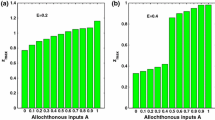Abstract
In this article, the global dynamics of a predator–prey system incorporating combined harvesting has been investigated. The additional food is being provided to the predator, accordingly, modified Holling type-II functional response is considered in the model. The presence of toxicants affect the quality of food for both the species, reducing their growth. The steady states of the system are obtained under some suitable conditions. The local and global dynamics are explored. The conditions for permanence and existence for bionomic equilibrium of the system have been investigated. It is also observed that the system exhibits local bifurcations i.e., transcritical, Hopf, saddle-node as well as global bifurcations i.e., Bogdanov–Takens bifurcation and generalized Hopf bifurcation with respect to the suitable set of parameters. Optimal harvesting policy is discussed with the help of Pontryagin’s maximum principle to preserve both the species from extinction and maintain a sustainable fishery. Numerical simulations are carried out for the suitable choice of parameters.
















Similar content being viewed by others
References
Hallam, T.G., Clark, C.W.: Non-autonomous logistic equations as models of populations in a deteriorating environment. J. Theor. Biol. 93, 303–311 (1982)
Hallam, T.G., Clark, C.E., Jordan, G.S.: Effects of toxicants on populations: a qualitative approach II, first order kinetics. J. Math. Biol. 18, 25–37 (1983)
Hallam, T.G., De Luna, T.J.: Effects of toxicants on populations: a qualitative approach III, environmental and food chain pathways. Theor. Biol. 109, 411–429 (1984)
Deluna, J., Hallam, T.G.: Effect of toxicants on population: a qualitative approach IV. Resource–consumer–toxicant models. Ecol. Model. 35, 249–273 (1987)
Freedman, H.I., Shukla, J.B.: Models for the effect of toxicant in a single-species and predator–prey systems. J. Math. Biol. 30, 15–30 (1990)
Dubey, B., Hussain, J.: A model for the allelopathic effect on two competing species. Ecol. Model. 129, 195–207 (2000)
Shukla, J.B., Agawal, A.K., Dubey, B., Sinha, P.: Existence and survival of two competing species in a polluted environment: a mathematical model. J. Biol. Syst. 9, 89–103 (2001)
Chattopadhyay, J.: Effect of toxic substances on a two-species competitive system. Ecol. Model. 84, 287–289 (1996)
Maynard Smith, J.: Models in Ecology. Cambridge University Press, Cambridge (1974)
Kar, T.K., Chaudhuri, K.S.: On non-selective harvesting of two competing fish species in the presence of toxicity. Ecol. Model. 161, 125–137 (2003)
Das, T., Mukherjee, R.N., Chaudhuri, K.S.: Harvesting of a prey–predator fishery in the presence of toxicity. Appl. Math. Model. 33, 2282–2292 (2009)
van Baalen, M., Kivan, V., van Rijn, P.C.J., Sabelis, M.W.: Alternative food, switching predators, and the persistence of predator–prey systems. Am. Nat. 157, 512–524 (2001)
van Rijn, P.C.J., van Houten, Y.M., Abelis, M.W.: How plants benefit from providing food to predators even when it is also edible to herbivores. Ecology 83, 2664–2679 (2002)
Harwood, J.D., Obrycki, J.J.: The role of alternative prey in sustaining predator populations. In: Hoddle, M.S. (ed.) Proceedings of the Second International Symposium on the Biological Control of Arthropods, vol. 2, pp. 453–462 (2005)
Srinivasu, P.D.N., Prasad, B.S.R.V., Venkatesulu, M.: Biological control through provision of additional food to predators: a theoretical study. Theor. Popul. Biol. 72, 111–120 (2007)
Sahoo, B.: Predator–prey model with different growth rates and different functional responses: a comparative study with additional food. Int. J. Appl. Math. Res. 1, 117–129 (2012)
Sahoo, B.: Effects of additional foods to predators on nutrient consumer predator food chain model. ISRN Biomath. (2012). https://doi.org/10.5402/2012/796783
Sahoo, B., Poria, S.: Disease control in a food chain model supplying alternative food. Appl. Math. Model. 37, 5653–5663 (2013)
Srinivasu, P.D.N., Prasad, B.S.R.V.: Role of quantity of additional food to predators as a control in predator–prey systems with relevance to pest management and biological conservation. Bull. Math. Biol. 73, 2249–2276 (2011)
Srinivasu, P.D.N., Prasad, B.S.R.V.: Time optimal control of an additional food provided predator–prey system with applications to pest management and biological conservation. J. Math. Biol. 60, 591–613 (2010)
Nagumo, M.: Uber die Lage der Integralkurven gew onlicher Differentialgleichungen. Proc. Phys. Math. Soc. Jpn. 24, 551 (1942)
Perko, L.: Differential Equations and Dynamical Systems. Texts in Applied Mathematics, vol. 7, 2nd edn. Springer, New York (1996)
Sen, M., Srinivasu, P.D.N., Banerjee, M.: Global dynamics of an additional food provided predator–prey system with constant harvest in predators. Appl. Math. Comput. 250, 193–211 (2015)
Clark, C.W.: Mathematical Bioeconomics: The Optimal Management of Renewable Resources. Wiley-Interscience, New York (1976)
Pontryagin, L.S., Boltyonskii, V.S., Gamkrelidze, R.V., Mishchenko, E.F.: The Mathematical Theory of Optimal Processes, Translated from the Russian by K. N. Trirogoff. In: Neustadt, L.W. (ed.) Interscience Publishers, Wiley, New York (1962)
Govaerts, W., Kuznetsov, Y.A., Dhooge, A.: Numerical continuation of bifurcations of limit cycles in matlab. SIAM J. Sci. Comput. 27, 231–252 (2005)
Riet, A.: A Continuation Toolbox in MATLAB. Master thesis, Mathematical Institute, Utrecht University (2000)
Mestrom, W.: Continuation of Limit Cycles in MATLAB. Master thesis, Mathematical Institute, Utrecht University (2002)
Dhooge, A., Govaerts, W., Kuznetsov, Y.A.: MATCONT, a Matlab package for numerical bifurcation analysis of ODEs. ACM Trans. Math. Softw. 29, 141–164 (2003)
Author information
Authors and Affiliations
Corresponding author
Additional information
Publisher's Note
Springer Nature remains neutral with regard to jurisdictional claims in published maps and institutional affiliations.
Rights and permissions
About this article
Cite this article
Rani, R., Gakkhar, S. The impact of provision of additional food to predator in predator–prey model with combined harvesting in the presence of toxicity. J. Appl. Math. Comput. 60, 673–701 (2019). https://doi.org/10.1007/s12190-018-01232-z
Received:
Published:
Issue Date:
DOI: https://doi.org/10.1007/s12190-018-01232-z
Keywords
- Predator–prey model
- Additional food
- Stability
- Local and global bifurcations
- Persistence
- Bionomic equilibrium
- Optimal harvesting policy




